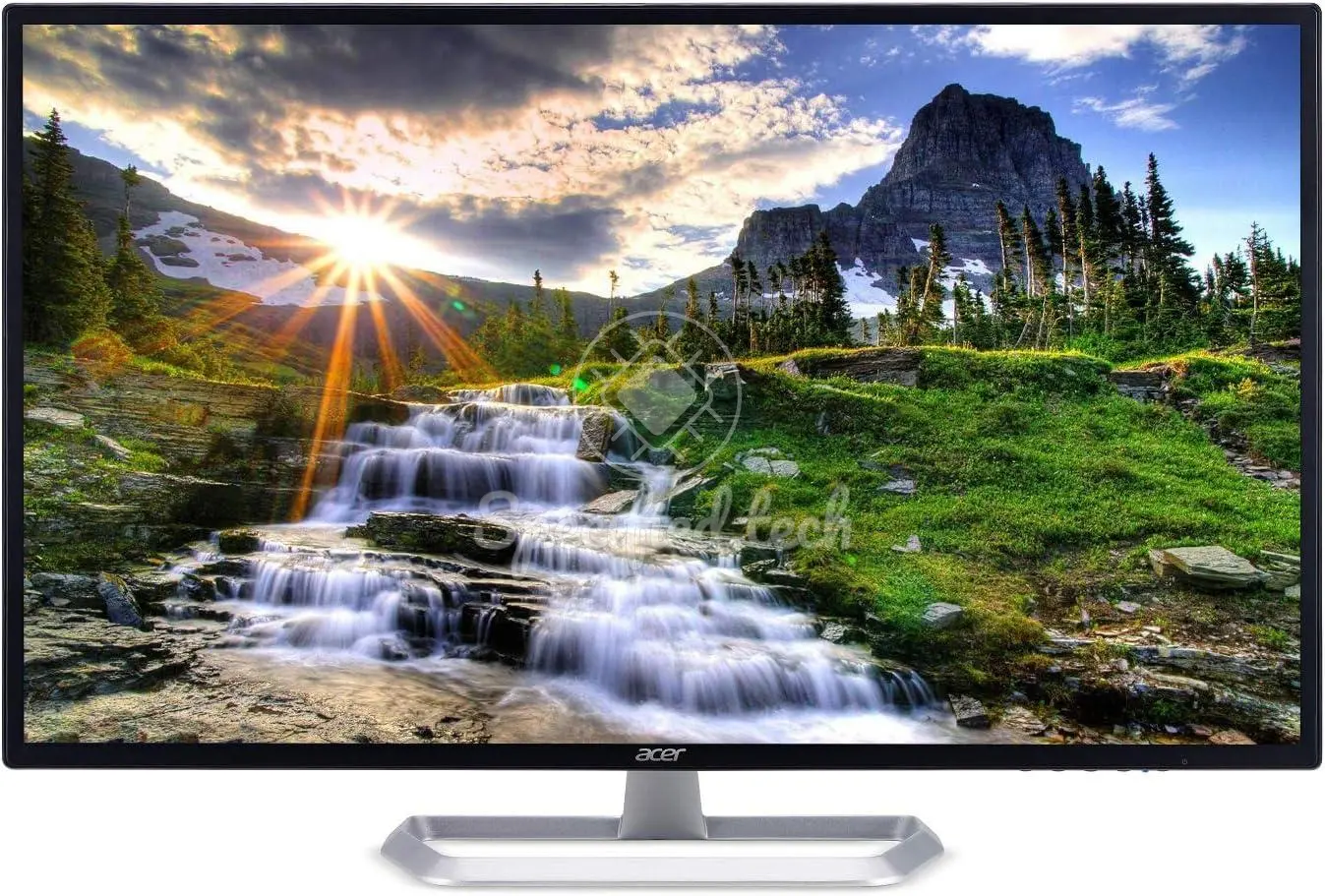
Within this article we will take a closer look at the technical specifications of the EB321HQU Cbidpx monitor from Acer. For this we will talk about all possible categories that could be relevant. To start with, we will look at the display, talk about the design and in the next section we will go into the features of the monitor. Other features such as power consumption, connectors and certifications will follow later in the text.
Display
The display is sized at 31 inches ( 80.1 cm on the diagonal). While classic CRT monitors were built with a screen ratio of 4:3, this monitor has a ratio of 1.778 : 1 (width to height). Approximately 89.1 % of the front surface of the monitor is covered by the display, while the remaining area consists of screen edges that do not allow any image output. If you want to set up several monitors next to each other, it is advisable to prefer models with the narrowest possible edges. The display is a IPS panel. The panel has a resolution of 2560 x 1440 px. The pixel density is 93 ppi. The pixel pitch is 0.273 mm. The continuous possible brightness specified by the manufacturer Acer is 300 cd/m2. The panel is illuminated by W-LED. The built-in panel ensures stable color reproduction of the image, even at deviating viewing angles, by means of its 178 ° (horizontal) viewing angle. Acer promises stable color reproduction moreover within a 178 ° vertical angle. Vertically, however, the image renews at a minimum rate of 60 hz up to 60 hz. The minimum response time of the monitor is ms. The display panel is Anti-glare/Matte (3H).
Color representation
The panel has a bit depth of 10 per color channel, but what does that mean? The number of bits determines how many colors can be encoded for the individual pixels of the display. For an 8-bit panel, for example, this is 256 different colors (2^8 = 256). However, since we usually display three different colors per pixel at the same time, in theory about 16 million (256^3) different colors are possible by mixing the three pixels. A 10-bit panel could even display a billion colors. According to the manufacturer, the coverage of the NTSC 1953 color space is 72 %.
Contrast ratio
Contrast ratio is a common measurement used to represent the maximum relative differences in brightness between black and white. It describes the ability of a screen or projector to produce a high-contrast image and is the quotient of the maximum and minimum displayable luminance. The higher the values are away from each other, the stronger the quantitatively seen difference between black and white is set up, which in turn results in an improved image quality. This monitor from Acer has a static contrast ratio of 1200 : 1 , according to the manufacturer. In contrast to the static contrast ratio, the dynamic contrast ratio changes the brightness of the panel itself in addition to the difference measurement from black to white. In addition to the difference between the brightest and the darkest pixel, the backlight is thus changed. Since the brightness of the panel may not be able to be adjusted exactly to a single pixel, a so-called halo effect is possible. The value of 100000000 : 1 of dynamic contrast ratio for the monitor EB321HQU Cbidpx cannot provide any information about the severity of the halo effect here. Therefore, it is more useful to compare the static contrast ratio.
HDR
The monitor supports all HDR modes listed here:
screen design
Acer Specifies the following dimensions for the monitor EB321HQU Cbidpx without stand/feet: 42.4 cm x 72.6 cm x 5 cm (HxWxD)
The size of the monitor (stand included) is 48 x 72.6 x 18 cm (HxWxD). The device weighs in total (i.e. also measured with the stand) 6.4 kg. Without stand, the monitor weighs 5.8 kg. Speaking of weight without a stand and thus wall or table mounts. The monitor supports a Vesa mounting.
Rotate, tilt and swivel
The monitor from Acer cannot be rotated. The monitor cannot be swiveled. This feature could be retrofitted with a third-party stand. The tilt of the monitor EB321HQU Cbidpx can be individually adjusted to optimize the viewing angle and increase comfort during use. The angle of inclination to the rear is 15. The monitor can be tilted forward by 5 degree.
camera
This monitor does not have a camera.
Features
- Flicker Free: Acer 's Flicker Free technology minimizes distracting screen flicker, allowing you to work and/or play longer without restrictions.
- The display/monitor supports Frame Rate Compensation.
Anyone who works a lot on the computer spends many hours a day in front of the screen. Excessive screen work can damage the eyes. This effect can be particularly pronounced during the darker hours and in the winter months. Many monitor manufacturers have now reacted and offer technologies and settings to reduce the blue component, which is primarily controversial. Depending on the manufacturer, these can be called "Low Blue Light", "Low Blue Light Technology", "SoftBlue" or even "Eye Saver Mode" and function differently. However, it is only important that Acer offers a technology to reduce the blue content in its monitor EB321HQU Cbidpx.
Power consumption
The maximum power consumption (peak) specified for this monitor is 50 w. In standby mode, the device consumes approximately 0.45 w. When switched off, on the other hand, the monitor consumes only 0.4 w. The monitor can be operated on a 110v power supply. The monitor can be operated on a 220v power supply. The power grid has to supply a frequency of 50 hz to 60 hz.
Packaging
The monitor is packaged in a cardboard box measuring 52 x 92.7 x 15.2 cm (height x width x depth). The box together with the monitor weighs about 8.6 kg.
Further information
- 100x100

